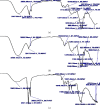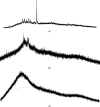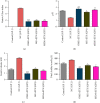Evaluation of Ulcer Protective Activity of Morus alba L. Extract-Loaded Chitosan Microspheres in Ethanol-Induced Ulcer in Rat Model
- PMID: 36212972
- PMCID: PMC9546716
- DOI: 10.1155/2022/4907585
Evaluation of Ulcer Protective Activity of Morus alba L. Extract-Loaded Chitosan Microspheres in Ethanol-Induced Ulcer in Rat Model
Abstract
Due to an unhealthy lifestyle, gastric ulcers have become a very common disease these days. Moreover, the side effects linked with the prolonged use of conventional treatments have shifted the paradigm towards herbal therapies. The leaves of Morus alba L. (Family-Moraceae) have been traditionally used for a large number of metabolic diseases. In the present research, we focused on the development of chitosan microspheres using extracts of leaves of Morus alba L. and their evaluation for gastroprotective efficacy against ethanol-induced ulcers in experimental rats. The process of development of M. alba extract microsphere (MEM) is also optimized using the Box-Behnken design. The formulation was prepared at optimized conditions (chitosan concentration (1.66% w/w), volume of glutaraldehyde (4.69 mL), and stirrer rotation per minute, RPM, 854.8), and the percentage yield (Y 1) of the resulted microspheres is ∼95% with an encapsulation efficiency (EE) of (Y 2(rutin)) ∼86%, Y 2(quercetin)) ∼85%, and particle size (Y 3) of ∼40 µm. The MEM prepared at optimized conditions can also be characterized for various parameters to ensure the uniformity of parameters. Also, the drug release studies indicated that the percentage release of rutin and quercetin from MEM was enhanced as compared to M. alba extract (ME) alone. Furthermore, in vivo analysis of the antiulcer potential of pretreatment with ME and MEM (500 mg/kg p.o.) in rats indicated that mucosal lesions, gastric juice volume, and total acidity were significantly altered as compared to ethanol-treated animals. Histopathology of tissue sections also confirmed the protection of gastric mucosa on pretreatment with MEM at 500 mg/kg p.o. On the basis of these findings, we can conclude that prepared microspheres can be used to develop a sustained release formulation of extract for the management of gastric ulcers. However, additional research is needed to establish the specific mechanisms of M. alba's antiulcer efficacy.
Copyright © 2022 Sarita Garg et al.
Conflict of interest statement
The authors declare that there are no conflicts of interest.
Figures










Similar articles
-
Protective effects of alginate-chitosan microspheres loaded with alkaloids from Coptis chinensis Franch. and Evodia rutaecarpa (Juss.) Benth. (Zuojin Pill) against ethanol-induced acute gastric mucosal injury in rats.Drug Des Devel Ther. 2015 Nov 19;9:6151-65. doi: 10.2147/DDDT.S96056. eCollection 2015. Drug Des Devel Ther. 2015. PMID: 26640368 Free PMC article.
-
Evaluation of Antiulcer and Antioxidant Activity of Barleria gibsoniDalz. Leaves.Pharmacognosy Res. 2016 Oct-Dec;8(4):226-230. doi: 10.4103/0974-8490.188879. Pharmacognosy Res. 2016. PMID: 27695259 Free PMC article.
-
Evaluation of acute toxicity, genotoxicity and inhibitory effect on acute inflammation of an ethanol extract of Morus alba L. (Moraceae) in mice.J Ethnopharmacol. 2016 Dec 24;194:162-168. doi: 10.1016/j.jep.2016.09.004. Epub 2016 Sep 3. J Ethnopharmacol. 2016. PMID: 27596329
-
Cochlospermum regium (Mart. ex Schrank) Pilg.: Evaluation of chemical profile, gastroprotective activity and mechanism of action of hydroethanolic extract of its xylopodium in acute and chronic experimental models.J Ethnopharmacol. 2019 Apr 6;233:101-114. doi: 10.1016/j.jep.2019.01.002. Epub 2019 Jan 3. J Ethnopharmacol. 2019. PMID: 30611907
-
Antiulcer mechanisms of Vernonia condensata Baker: A medicinal plant used in the treatment of gastritis and gastric ulcer.J Ethnopharmacol. 2016 May 26;184:196-207. doi: 10.1016/j.jep.2016.02.049. Epub 2016 Mar 5. J Ethnopharmacol. 2016. PMID: 26956376
Cited by
-
Editorial: Application of plant secondary metabolites to pain neuromodulation, volume III.Front Pharmacol. 2023 Feb 21;14:1166272. doi: 10.3389/fphar.2023.1166272. eCollection 2023. Front Pharmacol. 2023. PMID: 36895948 Free PMC article. No abstract available.
-
Chitosan Nanoparticles for Gastroesophageal Reflux Disease Treatment.Polymers (Basel). 2023 Aug 20;15(16):3485. doi: 10.3390/polym15163485. Polymers (Basel). 2023. PMID: 37631542 Free PMC article. Review.
-
Opuntia ficus-indica (L.) Mill. - anticancer properties and phytochemicals: current trends and future perspectives.Front Plant Sci. 2023 Oct 4;14:1236123. doi: 10.3389/fpls.2023.1236123. eCollection 2023. Front Plant Sci. 2023. PMID: 37860248 Free PMC article. Review.
-
Comprehensive overview of different medicinal parts from Morus alba L.: chemical compositions and pharmacological activities.Front Pharmacol. 2024 Apr 17;15:1364948. doi: 10.3389/fphar.2024.1364948. eCollection 2024. Front Pharmacol. 2024. PMID: 38694910 Free PMC article. Review.
-
The Role of Natural and Semi-Synthetic Compounds in Ovarian Cancer: Updates on Mechanisms of Action, Current Trends and Perspectives.Molecules. 2023 Feb 22;28(5):2070. doi: 10.3390/molecules28052070. Molecules. 2023. PMID: 36903316 Free PMC article. Review.
References
-
- Kumar V., Abbas A. K., Aster J. C. Robbins Basic Pathology E-Book . Amsterdam, Nertherlands: Elsevier Health Sciences; 2017.
LinkOut - more resources
Full Text Sources
Miscellaneous

